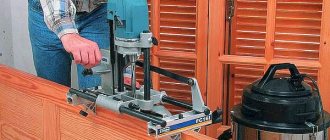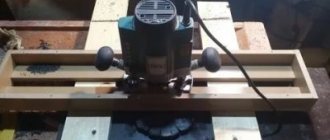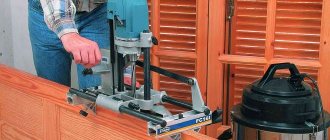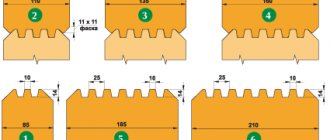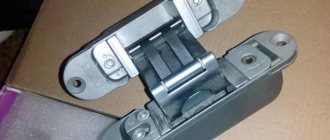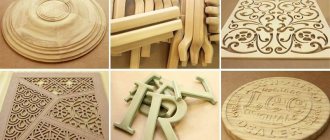When installing any door in the entrance opening, you need to prepare a place for the hinges and, if necessary, install locks. Home craftsmen use a chisel and a hammer for this. Professionals have already switched to a milling cutter for cutting locks. Let's consider how a manual milling machine can be used for operations not related to decorative surface finishing.
Preparing a door for a lock mortise Source moysignal.ru
Types of manual milling installations
Inserting a lock into an interior door with a router is much more practical than using a drill, much less a chisel. The latter tool generally requires certain skills. Otherwise, there is a risk of damage to the decorative coating of the door. In addition, this process takes quite a long time.
A hand router can complete the task in a very short time. And the quality of work is a bonus. The mechanism will make all the necessary grooves and recesses with extreme precision and without damaging the surface of the door. And the need for fine-tuning arises only in some cases. Usually, after the operation is completed, constipation can be installed immediately.
But the device does not insert hinges with a router until the very end. At the final stage, you still have to do a little work with a hammer and chisel. To select angles. But, after passing the cutter, this operation becomes simple and takes little time.
All manual milling cutters can be divided into 4 categories:
- vertical;
- edge;
- combined;
- special purpose.
A simple plunge router Source ytimg.com
A vertical router is also called a plunge router. It is used for cutting grooves. Moreover, the width and depth of the passage can be set in advance. This tool is often used as a router for cutting locks and hinges.
Edge routers process the edges of wooden products. They are used where decorative finishing is needed. Therefore, they also have another name - edging.
The combination tool is usually used by professional woodworkers. It combines the capabilities of both vertical and edge options. And it can also be considered as a device for inserting loops with a router.
Special-purpose power tools come in different varieties. It performs certain technological tasks. And the most common among craftsmen are dowel and lamella milling cutters. They are also called figireans. But all of them are used for curly processing of wood surfaces.
Instructions for installing hinges in interior doors with your own hands
Author of the article: Alexandra Ivanova March 18, 2021
Door hinges are an important element of an interior door, on which its functional purpose and correct opening/closing depend. The most popular are mortise hinges. By following the instructions and recommendations of experienced craftsmen, you can install them yourself.
Tool selection criteria
Let's figure out how to choose a tool with a cutter for installing locks on doors. And also for preparation for hanging loops. And since the above operations are only part of the capabilities of the router, the recommendations boil down to the following.
Master at work Source psoriazugat.psopt.ru
See also: Catalog of companies that specialize in doors, windows and related work
You don't need too powerful a tool for housework. Most of its features are simply not useful. In addition, there is a small minus. A tool designed for more complex tasks than cutting a simple groove will not be able to provide the required high speeds. In addition, professional milling cutters weigh a lot.
Secondly, it is necessary to pay attention to the actual overhang of the working tool. In the technical documentation it is somewhat overstated. And therefore, later, during work, you have to drill out the grooves to install the lock with another tool.
An important parameter is ease of use. The device should not be heavy and have a sufficiently long cord. And also with a convenient location of control buttons. Its functionality must be thought out in advance. So that when working, you don’t have to urgently look for a replacement if the tool is not able to perform the required operation.
Convenient template for inserting loops Source avito.st
The equipment also plays an important role. The backlight option is very useful for a high-quality overview of the work area. And in addition to cutters for cutting in hinges and locks, the device must have various holders and additional attachments. It’s good if the kit already includes a special device that makes it easier to insert locks and hinges. It will be very useful especially for beginners.
Castle part
First of all, you need to select and prepare a feather drill. The diameter should be 2-4 mm larger than the thickness of the embedded part of the lock. It’s better to give a larger margin: it’s difficult to ideally hold the drill perpendicular to the end of the door; there will probably be a small error due to the fact that the drill may twitch slightly along different fibers . To ensure that the hole does not turn out to be too small, or, conversely, too deep, we wrap the perk with electrical tape at a level slightly larger than the dimensions of the recessed part. Markers and pencils are not very suitable for marking as they wear out quickly.
@youtube.com, channel DIY apartment renovation (Remontkv.pro)
After the nest is ready, we are not in a hurry to choose a recess for the cover. Firstly, we check whether the lock fits into the socket , and secondly, we set up the router on the block. And only then we select the recess.
The hole for the handle is drilled last. And then after we once again assessed the lock against the main frame and made sure that we had not made a mistake with the preliminary markings. Again, take a drill with a diameter of 12-16 millimeters - the handle will block the hole, and no one has canceled the error in measurements.
A common mistake is that the mating part of the lock on the frame is marked until the door is already installed and the mounting foam has dried. Don't do this! The answer will take its position only after installation, so do not try to calculate or guess it. There is no need to rush here, otherwise, most likely, you will have to interrupt it in place - for some reason the lock tongue will not fall into the slot intended for it.
Source
Setting up the router
Inserting loops with a router begins with setting up the tool. The device itself will perform the entire operation if you set the necessary parameters on it in advance. In particular, it is necessary to set the required engine speed. And also set the desired processing depth.
To do this, you will need to bring the tool to a neutral position:
- Place the router on a hard and level surface.
- Loosen the feed pin lock.
- Lower the cutter to the level of the supporting surface.
- Set “0” on the processing depth scale.
- Secure the pin.
Professional router Source routerforums.com
Using a template
The procedure in question is also carried out with a special template. You can get it yourself as follows:
- First, the offset of the cutter is measured.
- You can determine the dimensions of the template for insertion using conventional measuring tools.
- 2-3 passes are performed.
- This step produces a finished hole.
After receiving the special element in question, you can embed the hinges using other various tools.
In conclusion, we note that the process of cutting hinges with a router is carried out to obtain a high-quality niche. The features of the tool can significantly speed up the process and reduce the likelihood of serious defects. By using special attachments, you can significantly expand the capabilities of the device.
Preparing doors and working with a router
Let's take a closer look at how to cut grooves for a lock and hinges on a door using a router. Let's look at an example of hanging loops. The lock is cut in identically, using a similar algorithm. In order not to apply markings manually, it is better to purchase special templates. Their cost is low, and the store has a wide assortment for any model of locks and awnings.
Installing a cutter into a tool Source amazon.com
Step-by-step instructions for working with a router:
- The door is securely fixed to the floor with the side end surface facing up. It is better to use special clamps.
- The places where the loops will be located are marked.
- A template is placed on the marking and secured.
- The router is adjusted to the desired depth and placed on top of the template.
- Wood is removed from the inside of the template using a milling cutter.
- At the end of the operation, the router along with the device is removed to the side.
- The groove is refined with a chisel (the corners are selected).
- Hinges are installed on the treated areas and secured with fasteners.
Choosing good cutters
All cutters are divided into types according to geometry:
- End;
- Worm-shaped;
- Cylindrical;
- Conical.
They are also divided according to the material being processed:
- Aluminum;
- Ceramics;
- Steel;
- Plastic;
- Soft metals;
- Tree.
The significant difference is the size of the shank. Most often, cutters with 6 mm and 8 mm are used, less often with 12 mm shanks. There are their analogues, similar, but not identical. They are measured in 1/2 and 1/4 inches. In terms of millimeters, these are 6.35 and 12.7, but it is prohibited to use them in a collet chuck designed for shanks with sizes of 6 and 12 mm.
A collet chuck differs from a jaw chuck in that it does not tolerate errors. In this regard, the fixation is unreliable, and during operation the cutter can fly out and cause injury to the operator. To avoid such situations, you should use cutters for a router, which a sales consultant in the store will help you choose.
When buying cutters, you should choose only high-quality products. They will last for more than one day, and will not break during operation, as happens with cheap, non-certified products. It is better if the coating of the product is made of high-carbon stainless steel.
Furniture hinge insertion
To select a large-diameter blind hole with a hand router, you need to make a template yourself. It has a stop bar, thanks to which the tool can be easily positioned on the furniture door. It is done very simply.
Milling for a furniture hinge Source amazon.com
A rectangle with sides 280×140 mm is cut out of plywood 4-5 mm thick. Divide the width in half and draw a line. We retreat 70 mm from the corners along one of the sides along the length and also connect these points with a line. At the intersection we drill a hole with a diameter of 51 mm.
We select a wooden plank for support. Its length is 140 mm, and its cross-section is 5×30 mm. We place the stop at the very edge of the hole, stepping back from the edge of the rectangle by 15 mm. We attach the plank with glue and small nails. The template is ready.
The depth is set on the router to 11.5 mm. The template is applied to the furniture board, and the strip rests against its end. And in several passes the groove is selected. In this way, a blind hole is made for a standard furniture hinge with a 35 mm cup.
Calculation principle
For example, there is a 16 mm straight cutter and a 30 mm diameter copy sleeve. It is required to make vertical holes for round bench stops with a diameter of 21 mm. Substituting the values into the formula, we find the size of the circle cut out in the template:
D = 21 + 30 – 16 = 35 (mm).
Mark the plywood and make a hole with a drill bit of the appropriate diameter.
Sand the edges and surfaces with sandpaper.
Use one piece of plywood for several templates at once. Just don’t forget to label the holes, indicating the caliber of the cutter used and the diameter of the circle being cut.
Briefly about the main thing
To cut a lock with a router or hang hinges on a door, you need to choose the right tool. It is best to use a simple submersible model, since the combined model is heavy. This will create certain inconveniences, especially if there is no experience in such wood processing.
Using a router to cut in fittings is easy. But the process is greatly simplified if there are special templates. Having placed the device in the desired place, all that remains is to set the required processing depth on the tool and install it on top.
When working, you need to carefully monitor the process in order to notice overload in time. It can occur if the wood structure is too hard. Then you just need to reduce the speed of the tool using a special switch on the body.
Lock markings
Immediately estimate the height at which it would be convenient for you to place the door handle. For some it is better to take 80 centimeters from the bottom of the door leaf, for others it is better to raise it to a meter. a handle height of about 90 cm is usually comfortable . This is where we start when marking.
We place the mortise lock on the door frame so that its bar is flush with the end of the door. Mark with a pencil the point where the handle will be located.
@youtube.com, channel DIY apartment renovation (Remontkv.pro)
Next, insert the door leaf into the latches with the lock side up. We apply the strip to the end, outline it, making sure that it is attached to the door evenly, without distortions. After this, use a chisel to carefully knock out the outline around the perimeter of the marking. To clearly determine the seat for the lock, I advise you to make auxiliary vertical markings on the lock end of the door , finding the middle of its thickness, as a rule, this is 16-20 millimeters . It will come in handy when drilling a socket with a feather drill.

